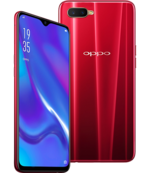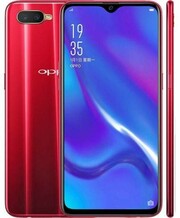Oppo K1
Ausstattung / Datenblatt

Secondary Camera: 25 MPix f/2.0, 1/2.8", 0.9µm
Preisvergleich
Durchschnitt von 6 Bewertungen (aus 7 Tests)
Testberichte für das Oppo K1
Quelle: Tech2
 EN→DE Archive.org version
EN→DE Archive.org versionThe Oppo K1 is a practical alternative to the Redmi Note 7 Pro and the Galaxy A30.
Einzeltest, online verfügbar, Mittel, Datum: 15.03.2019
Bewertung: Gesamt: 70% Leistung: 70% Bildschirm: 80% Mobilität: 80% Gehäuse: 70%
Quelle: India Today
 EN→DE Archive.org version
EN→DE Archive.org versionThe Oppo K1 offers a few interesting features to keep a user satisfied. The attractive gradient design and teardrop display is a nice sight to have every time you pick up the device. The AMOLED panel offers rich, vibrant colours and sharpness, which makes it great for watching videos and playing games. The Snapdragon 660 is a smooth and powerful chipset that is capable of handling whatever you throw at it, while at the same time keeps the Oppo K1 cool from the inside.
Einzeltest, online verfügbar, Mittel, Datum: 28.02.2019
Bewertung: Gesamt: 75%
Quelle: Tech PP
 EN→DE Archive.org version
EN→DE Archive.org versionAll of which makes the Oppo K1 a very good debutant for Oppo’s new K series of devices. The big question, of course, is: should you be investing Rs 16,990 in it? Well, Oppo deserves credit for taking on the likes of Xiaomi, Realme, Honor, and Nokia with a device that is not really a “me-too” one. The K1’s troika of AMOLED display, in-display fingerprint scanner, and drop notch are not commonplace at its price tag. And allied with a good processor and decent cameras, it is quite a formidable proposition. Yes, it does cost more than the likes of the Realme 2 Pro, the Nokia 6.1 Plus and the Redmi Note 6 Pro, but it does also legitimately bring more to the table. It is priced just above the Rs 15,000 price segment, but if marketed well, it could be a headache for all its members, and even its own successors, considering the benchmark it sets. For, the Oppo K1 does not try just to compete in its price segment but also to redefine what people expect in it.
Einzeltest, online verfügbar, Lang, Datum: 19.02.2019
Bewertung: Gesamt: 80% Preis: 85% Leistung: 85% Gehäuse: 80%
Quelle: The Indian Express
 EN→DE Archive.org version
EN→DE Archive.org versionOppo K1 is a mid-range smartphone that offers its users a lot of good features along with a decent in-display fingerprint sensor at Rs 16,990. During the review period, I was personally quite impressed by what the device could do at such a price point. At the price, it has great performance, a good battery, impressive cameras and much more. It is also the cheapest smartphone you can get with an in-display fingerprint sensor.
Einzeltest, online verfügbar, Lang, Datum: 16.02.2019
Bewertung: Gesamt: 80%
Quelle: NDTV Gadgets
 EN→DE Archive.org version
EN→DE Archive.org versionKeeping in mind that the Oppo K1 is the only phone with an in-display fingerprint sensor in its price band, the launch price of Rs. 16,990 is not too bad. We hope it will drop eventually and fall in line with other Snapdragon 660 powered smartphones with comparable RAM and storage configurations, such as the Realme 2 Pro (Review) or the Vivo V9 Pro ₹ 15,388 (Review).
Einzeltest, online verfügbar, Lang, Datum: 08.02.2019
Bewertung: Gesamt: 80% Preis: 80% Leistung: 80% Bildschirm: 90% Mobilität: 80% Gehäuse: 80%
Quelle: Android Authority
 EN→DE Archive.org version
EN→DE Archive.org versionIt’s never been a better time for mid-range smartphone users, and the Oppo K1 represents another great option for prospective buyers. The phone looks plenty good, is powerful enough and has a great screen to boot. The in-display fingerprint scanner is a cool addition that should sweeten the deal. The phone is priced at 16,990 rupees (~$240) making it a fantastic option for users in the sub 20,000 rupees (~$280) segment.
Einzeltest, online verfügbar, Mittel, Datum: 07.02.2019
Quelle: Gogi.in
 EN→DE Archive.org version
EN→DE Archive.org versionOPPO K1 is using a powerful processor, looks premium and gives a decent battery life of one to one and a half days with mixed usage. Another very good handset to buy if you are looking for power with powerful looks.
Einzeltest, online verfügbar, Mittel, Datum: 06.02.2019
Bewertung: Gesamt: 86%
Kommentar
Qualcomm Adreno 512: Grafikchip für Smartphones und Tablets, integriert im Qualcomm Snapdragon 660 SoC. Basiert auf die 500er Grafikarchitektur wie der schnellere Adreno 520 im Snapdragon 820. Qualcomm gibt bis zu 30% höhere Performance an (wahrscheinlich im Vergleich zum Adreno 510).
Diese Karten können nur sehr alte und sehr anspruchslose 3D Spiele flüssig darstellen. Anwendungen wie Office, Internet surfen, Bildbearbeitung oder (SD) Videoschnitt sind jedoch ohne große Einschränkungen möglich.
» Weitere Informationen gibt es in unserem Notebook-Grafikkartenvergleich und der Benchmarkliste.
SD 660: Mittelklasse SoC mit 8 Kryo 260 Kernen (bis 2,2 GHz) und einem X12 LTE Modem (bis zu 600 Mbps Download).» Weitere Infos gibt es in unserem Prozessorvergleich Vergleich mobiler Prozessoren und der Prozessoren Benchmarkliste .


